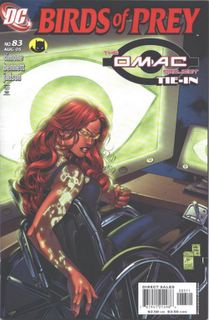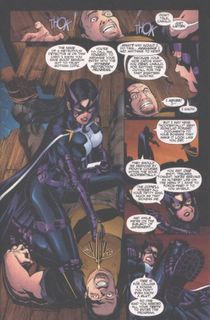Who are they, what are they, why are they?

Birds of Prey #80 - #84
Starting reading DC has changed my opinions about comics. That gorgeous, wretched munge of past stories we call "continuity" looks very different to the new reader. Since all comics die without new readers, their views (despite their manifest ignorance of their reading material) are disproportionately important. For now, and I suspect for a good time to come, I'm a new reader. What I'm saying - was it Groucho Marx who said "I have a theory about this but I'm not sure I believe it myself?" - is that my opinions of DC's comics matter because I don't know what the hell is going on.
Putting aside continuity for another day, what most strikes the new reader about Birds of Prey (and pretty much every other DC comic) is how inaccessible it all is.
Chris Claremont was the master of new reader accessibility. In every single comic he wrote, you'd see something like
Her name is Storo, or Ororo. Her name means beauty. He's Wolverine. He's the best there is at what he does.
Now I've been driven to distraction by this stuff over the years. Why are you telling us this, Chris? We bloody well know. Why the same formulae? If you have to say this, why not find different forms? And the answer is that he knows it's repetitive, but he doesn't care. Every comic book which has ever been written has had a new reader opening it. It's not repetitive to that person. Claremont's not writing for us at all. He figures if we're regular readers, we'll just ignore it and skip on to the story. Which we do.
Birds of Prey, on the other hand, takes the other approach. It holds onto its secrets like a toddler with a lollypop. Want to know Oracle's surname? A description of Dinah's powers? A full list of members? Why they're called a "community"? Whether the woman with the cap does anything other than fly planes and hang out with Oracle? The reason for the existence of "Birds of Prey"? If the information is in there, it's difficult to find. Five months on, and I have no idea why the Birds of Prey exist. Sure, I can see they fight crime, but are they government, non-government, privately funded? Do they have a headquarters? If any kind person wants to tell me the answers to these questions, please resist the temptation. I want to find out the old-fashioned way - from the writer.
In the meantime, for the good of the internet community, I have created a classic Stan Lee blurb which, in the absence of any better information from writer Gail Simone, I shall be using as my explanation for this group.
Caught in a shower of radioactive sleet and savaged by mutant protoplasm, the Birds of Prey were given magical but curiously unpleasant powers. Now, guarded by their bald mentor Barbara Splobble, they keep the streets of Gotham free from crime, and maintain a ceaseless watch for their arch-enemy, Pogon the Reprehensible, Master of the Thirty-sixth Dimension.
Gail Simone is a gifted writer. What sets her apart is her ability to write personalities. Many writers (I wouldn't want to name names, but you could probably have a go) struggle to make their characters appear as individuals. But there is a lightness, a dexterity about Simone's stories which make them a pleasure to read. Such as the scene where Barbara attempts to apologise to Huntress by telling her every embarrassing thing that has happened in her life. Few writers would think of this, and fewer would succeed in making it work. Simone writes well, and she breathes a life into her characters.
But (and isn't there always a "but"?) there's a problem. It's the violence. Teeth are knocked out, windpipes are elbowed and faces are headbutted. Sometimes you can't turn a page without coming across an unfortunate with blood and mucus splurting from his nose. We have two separate testicular assaults, which should at least give Sleestak plenty of material for his "Groin Injury Saturday" spot.
Is it gratuitous, this violence? Well, let's look at this.

As can be seen, Huntress has just stitched up this mafioso so he's going to have to rat to the cops. She's also given him a karate chop to the oesophagus. He's beaten and helpless. But he called her a slut. So, in the manner of a lairy, beered-up thug in a pub car park, she stamps on his head while making a "hasta la vista, baby" quip ("No one said you needed all your teeth to enter the program"). No, Gail, teeth are likely to be the least of his worries. Stamp on someone like this and you'll break their jaw. Brain damage could result, either from the violent impact itself or from a bone splinter. This is attempted murder, and all because he used an insult.
If you don't think there's something wrong about this scene, just transpose it, and have Wildcat stamping on the head of a female criminal. Is that OK? Here, of course, we're getting into gender differences and what is acceptable to be portrayed for a man and woman being different. Undoubtedly true, but writers are supposed to be using their insight to think ahead of the rest of society. Female-on-male violence is less prevalent than male-on-female, but that doesn't make it acceptable - I know a man with a partially collapsed lung after an assault by his wife. We should expect more from Gail Simone, whose Women in Refrigerators provided such an invaluable service by pointing a (perhaps implicitly misogynistic) streak of violence against women in comics. This scene makes it seem like Simone is saying that it's all right to have people in refrigerators, just as long as they're not women.
So do I disapprove of violence in comics? No, but (scenes like the above one excepted) I think the main problem is that the depiction of violence is uninteresting. Any talk that torture is inventive is wrong - it's pathetically easy to think of new ways to damage a human body. Corkscrew appendectomy, cheese-grated genitals, hydrochloric acid up the rectum - there's three ideas I've just thought of. Portrayal of violence should be minimised because it doesn't lead anywhere (how many times is Simone going to be able to portray a man's genitals being kicked before it becomes ridiculous?), and because it's all been done. At times, Birds of Prey is like flicking between an arthouse movie and a slasher pic.
But, on the other hand, examination of the motives for violence, or the aftermath of its effects, is well worth covering in a comic book. And Simone, with her flair for characterisation, would be one to do it so well.
Is Gail Simone the main offending writer here? I very much doubt it. This is a dock Warren Ellis could easily stand in. Not to mention dozens of much less imaginative writers, but I don't tend to read their output. As much as anything, my accusation is that Simone is not writing to her potential.
I have a feeling I'm going to regret saying that - Gail Simone is known to patrol the internet by night, and she has a Huntress-style robust manner of dealing with miscreant bloggers. Fortunately, she can't accuse me of posting spoilers - by the time my comics get to me, it's like they've been rowed across the north Atlantic by a wee fellow who stopped for a fortnight's lobster potting in the Azores.
And one last thing: the OMAC project tie-in connection was tenuous, to put it mildly. DC's marketing department is beginning to resemble Marvel's despotic Harrasid Caliphate during its Onslaught period. And that, kids, is not a good thing.



5 Comments:
In Simone's defense, Huntress is supposed to be the most brutal of the three protagonists, although that hasn't come out as much in Birds of Prey, where Simone has tended to de-emphasize that in the process of making the character more interesting (before Birds of Prey she used to show up a lot in the bat-books as a "too-harsh" anti-hero-type whose chief characteristic was not being liked by Batman).
I see what you mean about continuity and confusion. I've been familiar with Oracle since the late 80s/early 90s, so it hadn't occurred to me how opaque the setup might appear to be for a new reader. DC could stand to put a Marvel-style recap page in the front of their books, letting new readers know who the major characters are, what the premise of the book is, and what's been going on in the current story arc. For a book like Birds of Prey it's not as critical to enjoying the book, since the premise is pretty straightforward and the comic is pretty grounded in character interactions, but something like Legion of Superheroes, which has a huge roster of characters all with similar names in an unfamiliar setting and a long history of lineup changes and continuity warpings, could really use something like that.
The other thing that bothers me about Simone (and to be honest, I don't know if I've ever read her stuff) is that she implicitly accepts the portrayal of women in comics as sex objects. Yes, I know men are objectified too, but Simone defends Ed Benes's art, which is an egregious example of pneumatic boobularity as satirical. I don't have a problem necessarily with the representation of women in comics with tiny waists and huge breasts and men with rock-hard pecs that are wider than a continent, but it seems that Simone, who has taken a stand against violence against women in comics, would be a little more upset by the portrayal of women as leather-clad fetish objects. I'm just wondering if the stories she writes in Birds of Prey counter the art's sexual fascination, since I haven't read it (and I really should, because aparently it's pretty good).
So I'm a miscreant now, am I...?
I agree completely about the attitude towards new readers in comics these days. I just did a piece about it (plug, plug) over in my blog, entitled Seven Ways to Kill the Comics Industry. It's a self-destructive insanity that has been growing worse for decades.
Damn. I just thought of an 8th way.
Nice shaare
Post a Comment
<< Home